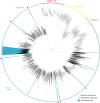Combining Phylogenetic and Network Approaches to Identify HIV-1 Transmission Links in San Mateo County, California
- PMID: 30574123
- PMCID: PMC6292275
- DOI: 10.3389/fmicb.2018.02799
Combining Phylogenetic and Network Approaches to Identify HIV-1 Transmission Links in San Mateo County, California
Abstract
The HIV epidemic in San Mateo County is sustained by multiple overlapping risk groups and is an important hub for HIV transmission in northern California. Limited access to care has led historically to delayed clinical presentation, higher rates of opportunistic infections, and an increased prevalence of antiretroviral drug resistance. The virologic and clinical consequences of treatment within these multiple ethnic and behavioral groups are poorly understood, highlighting the need for efficient surveillance strategies that are able to elucidate transmission networks and drug resistance patterns. We obtained sequence data from a group of 316 HIV-positive individuals in the San Mateo AIDS Program over a 14-year period and integrated epidemiologic, phylogenetic, and network approaches to characterize transmission clusters, risk factors and drug resistance. Drug resistance mutations were identified using the Stanford HIV Drug Resistance Database. A maximum likelihood tree was inferred in RAxML and subjected to clustering analysis in Cluster Picker. Network analysis using pairwise genetic distances was performed in HIV-TRACE. Participants were primarily male (60%), white Hispanics and non-Hispanics (32%) and African American (20.6%). The most frequent behavior risk factor was male-male sex (33.5%), followed by heterosexual (23.4%) and injection drug use (9.5%). Nearly all sequences were subtype B (96%) with subtypes A, C, and CRF01_AE also observed. Sequences from 65% of participants had at least one drug resistance mutation. Clustered transmissions included a higher number of women when compared to non-clustered individuals and were more likely to include heterosexual or people who inject drugs (PWID). Detailed analysis of the largest network (N = 47) suggested that PWID played a central role in overall transmission of HIV-1 as well as bridging men who have sex with men (MSM) transmission with heterosexual/PWID among primarily African American men. Combined phylogenetic and network analysis of HIV sequence data identified several overlapping risk factors in the epidemic, including MSM, heterosexual and PWID transmission with a disproportionate impact on African Americans and a high prevalence of drug resistance.
Keywords: California; HIV; network; phylogenetics; transmission links.
Figures


Similar articles
-
HIV-1 Drug Resistance and Genetic Transmission Networks Among MSM Failing Antiretroviral Therapy in South China 2014-2019.Infect Drug Resist. 2021 Aug 4;14:2977-2989. doi: 10.2147/IDR.S317187. eCollection 2021. Infect Drug Resist. 2021. PMID: 34377002 Free PMC article.
-
HIV-1 genetic transmission networks among men who have sex with men in Kunming, China.PLoS One. 2018 Apr 26;13(4):e0196548. doi: 10.1371/journal.pone.0196548. eCollection 2018. PLoS One. 2018. PMID: 29698467 Free PMC article.
-
Sex hustling, injection drug use, and non-gay identification by men who have sex with men. Associations with high-risk sexual behaviors and condom use.Sex Transm Dis. 1998 Aug;25(7):353-60. doi: 10.1097/00007435-199808000-00006. Sex Transm Dis. 1998. PMID: 9713915
-
Study of the impact of HIV genotypic drug resistance testing on therapy efficacy.Verh K Acad Geneeskd Belg. 2001;63(5):447-73. Verh K Acad Geneeskd Belg. 2001. PMID: 11813503 Review.
-
Molecular evolution methods to study HIV-1 epidemics.Future Virol. 2018 May;13(6):399-404. doi: 10.2217/fvl-2017-0159. Epub 2018 May 21. Future Virol. 2018. PMID: 29967650 Free PMC article. Review.
Cited by
-
Genetic network analysis of human immunodeficiency virus sexual transmission in rural Southwest China after the expansion of antiretroviral therapy: A population-based study.Front Microbiol. 2022 Aug 18;13:962477. doi: 10.3389/fmicb.2022.962477. eCollection 2022. Front Microbiol. 2022. PMID: 36060743 Free PMC article.
-
AUTO-TUNE: SELECTING THE DISTANCE THRESHOLD FOR INFERRING HIV TRANSMISSION CLUSTERS.bioRxiv [Preprint]. 2024 Mar 14:2024.03.11.584522. doi: 10.1101/2024.03.11.584522. bioRxiv. 2024. Update in: Front Bioinform. 2024 Jul 10;4:1400003. doi: 10.3389/fbinf.2024.1400003. PMID: 38559140 Free PMC article. Updated. Preprint.
-
Analysis of the Driving Factors of Active and Rapid Growth Clusters Among CRF07_BC-Infected Patients in a Developed Area in Eastern China.Open Forum Infect Dis. 2021 Feb 4;8(3):ofab051. doi: 10.1093/ofid/ofab051. eCollection 2021 Mar. Open Forum Infect Dis. 2021. PMID: 33728360 Free PMC article.
-
A 28-Year History of HIV-1 Drug Resistance and Transmission in Washington, DC.Front Microbiol. 2019 Mar 8;10:369. doi: 10.3389/fmicb.2019.00369. eCollection 2019. Front Microbiol. 2019. PMID: 30906285 Free PMC article.
-
AUTO-TUNE: selecting the distance threshold for inferring HIV transmission clusters.Front Bioinform. 2024 Jul 10;4:1400003. doi: 10.3389/fbinf.2024.1400003. eCollection 2024. Front Bioinform. 2024. PMID: 39086842 Free PMC article.
References
-
- California Department of Public Health (2015). California HIV Surveillance Report. Sacramento, CA: California Department of Public Health.
LinkOut - more resources
Full Text Sources
Molecular Biology Databases

